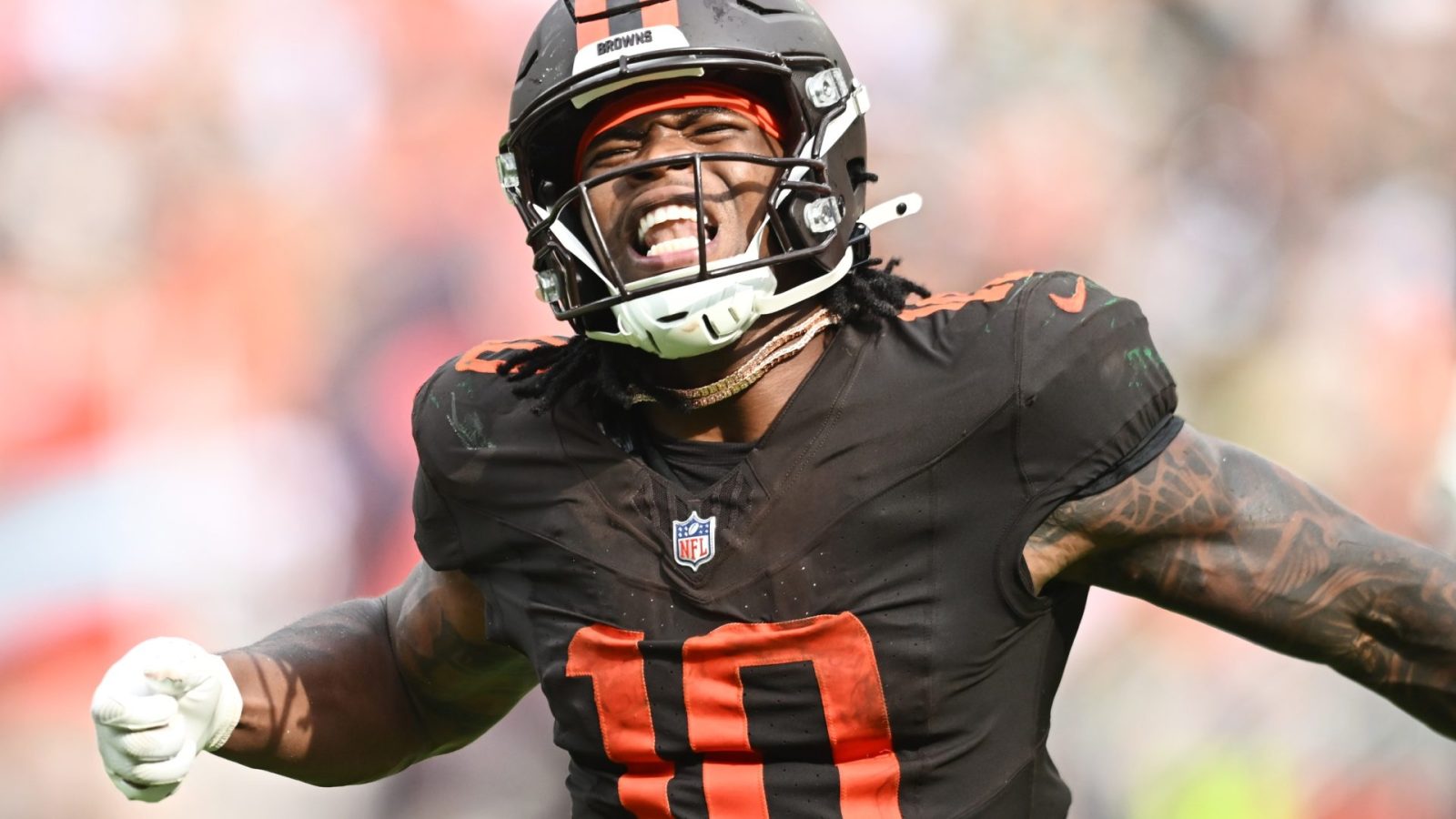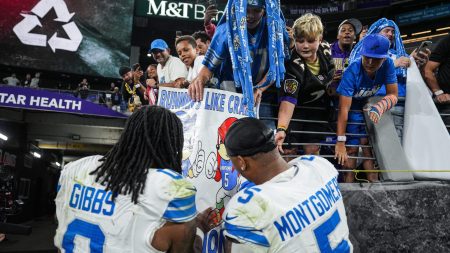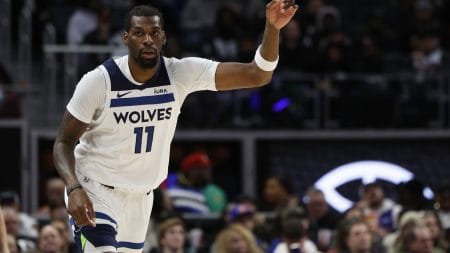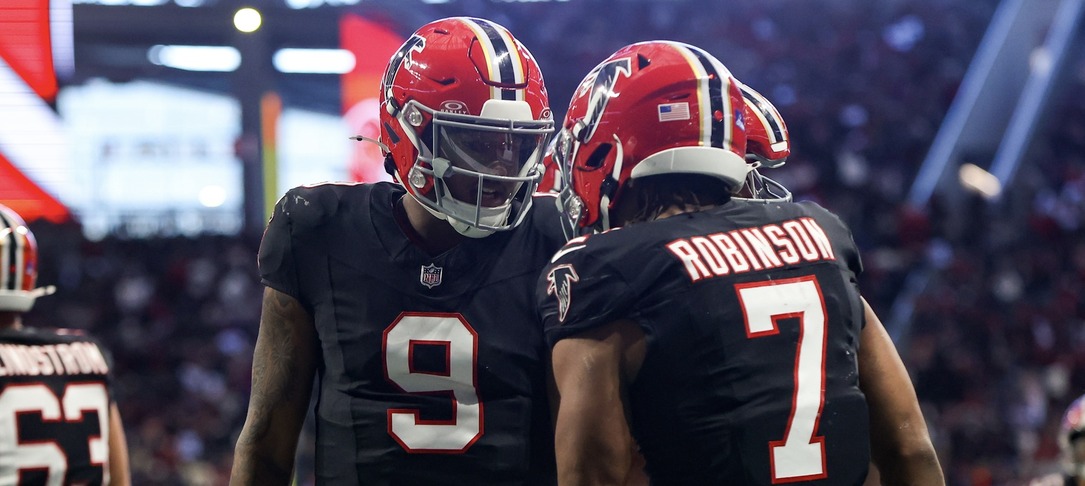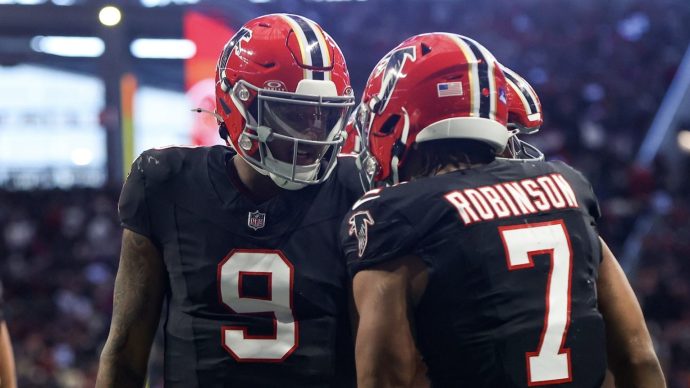Do you want to take your NFL betting and DFS experience beyond just the scoreboard? NFL rushing props offer a unique way to engage with individual player performances rather than final scores for point spreads.
These specialized wagers let you bet on specific stats like total rushing yards, touchdowns, or the game’s longest run. Instead of following team results, you’re tracking individual achievements on every carry and burst through the line.
Whether you’re looking for the best NFL rushing prop bets today, or targeting season-long futures, this guide has you covered. We break down how rushing props work, highlight expert picks for today’s and season-long bets, and share strategies to help you maximize your returns and improve your win rate.
Best DFS Apps in All States



Best NFL rushing props available today
Below, we’ll break down our best rushing props for Week 16 of the 2025 season.
Quinshon Judkins > 58.5 Rushing Yards
Cleveland will probably be dealing with some serious negative game-script here as heavy underdogs against Buffalo. But that’s okay – Judkins is going to get volume either way. When you’re trailing, you still need to try to establish something on the ground to keep the defense honest.
Look, Judkins has been terrible over the last couple of weeks, but I don’t believe it’s on him. His offensive line has not helped him at all – the Browns have been banged up upfront, and that’s made life miserable for any running back.
But here’s a good fix for that problem: how bad the Bills have been against the run this year. I think Judkins still has a big play in him, and he’s facing a really weak opponent in Buffalo’s run defense.
Even though the Bills are a little bit healthier now than they were earlier in the season, I still think we can pick on them. Check these numbers:
The Bills are allowing the 2nd-highest yards after contact per attempt, meaning they absolutely cannot wrap up and tackle. Guys are breaking through arm tackles and picking up extra yardage consistently.
They’re also giving up the 4th-highest yards before contact per attempt (via Fantasy Points), meaning they’re not hitting ball carriers in the backfield or at the line of scrimmage. Cleveland’s banged-up O-line should still be able to create some running lanes against this front seven.

Tony Pollard > 58.5 Rushing Yards
The Titans’ offense has looked better collectively in recent weeks. Cam Ward has been more consistent, and the further they move away from former head coach Brian Callahan’s system, the better things have gotten. Everything is simplified now, and the run blocking has been much better.
Tennessee will take on a Chiefs team that has absolutely nothing to play for, and they’ll be without Patrick Mahomes, meaning Kansas City might not be able to sustain drives that much on offense. Rashee Rice is also out, so their offense is in complete shambles right now.
On the defensive side of the ball, Chris Jones is banged up – not sure if he’s going to be available or not. But either way, I think the Titans’ run game with Tony Pollard, a team with nothing to lose, should find success against a defense where morale has to be low all around.
The Chiefs are completely knocked out of the playoffs for the first time in what seems like forever, and you can bet that affects effort and execution.
This isn’t a motivated, locked-in Kansas City defense. This is a group going through the motions in a meaningless game.
I like Pollard to clear this number comfortably, and this game might be a little bit more competitive than maybe some people think when you consider all the circumstances.
Best NFL DFS Pick’Em Sites
We love the NFL DFS pick’em projections available at top-flight daily fantasy sites like Underdog, DraftKings Pick6, and Sleeper. They offer a very similar experience to player props.
You’ll often find a lot of value and strong payouts available at legal DFS sites. These apps are also available in many states that don’t yet have legal online sports betting.
The best sportsbooks for betting on NFL rushing props
The sportsbook(s) you use for NFL rushing props can affect the odds you get, the variety of rushing prop bets available, and any sign-up bonuses or NFL-specific bonuses you might earn when placing your bets. Below are our favorite sportsbooks and the sign-up offers they currently offer.

What single-game rushing prop bets can you make?
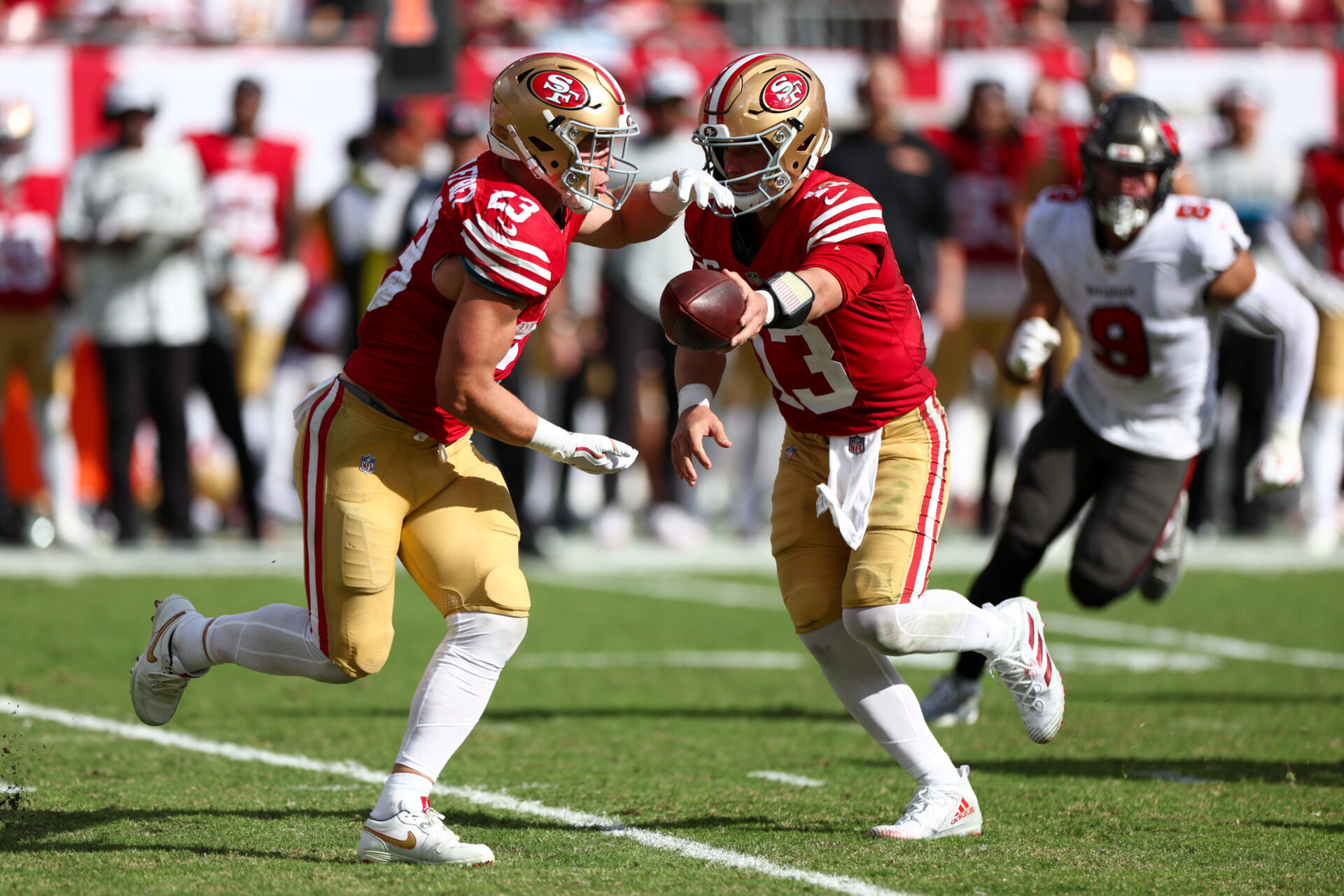
Single-game rushing props are bets on a single running back in a single game. You pick his yards, his carries, or if he scores, because those are simple, clear targets. You aren’t trying to pick the winner of the game or the spread, which helps when the score is hard to call.
Choose rushing prop bets when the matchup and how the game is going point to more runs, because more runs mean more chances to win your bet.
Example: Over 64.5 rushing yards for the starting RB at -110. If he gets 65 or more, you win; 64 or less, you lose.
Player rushing yards over/under (single game)
Sportsbooks set a rushing yards number for a player, and you pick the over or under, with no need to think about who wins the game or by how much.
Look at the matchup. If the run defense is soft, the runner has space, and missed tackles turn into extra yards. And think about game flow, because teams with a lead usually run more to burn the clock and keep the ball, which means more carries. Also, check the offensive line. If the blockers are good, they push defenders back, and the runner has room to run. If they’re weak, he gets hit right away, and the play goes nowhere.
Keep an eye on weather and late injuries too, because wind or rain or a muddy, sliding field can influence a team to take more runs, and a surprise inactive or an injured lineman can change who gets the carries and how far those carries go.
Example: Saquon Barkley’s rushing line is 85.5 against the Eagles, and if you take the over and he finishes with 90yards, you win because 90 is higher than 85.5, and the final score doesn’t matter.
Player rushing touchdowns (single game)
This bet is all about whether a player scores at least one rushing touchdown in the game. Some sportsbooks also let you bet on two or more, which obviously pays more because it’s harder.
Red-zone work matters with these bets, because carries near the goal line turn into touchdowns more often. And the opposing defense matters because weak run defenses give up more rushing scores. Also, team scoring potential matters because high-scoring teams reach the red zone more, so there are more chances for them to score each game.
Play-calling in short yardage is another thing to look at, because some teams run at the goal line, which puts the ball in your chosen guy’s hands.
Example: If Joe Mixon’s line is 0.5 against the Ravens, the over wins if he scores once or more. If he fails to score at all, then the bet loses at zero for the under.
Player rushing attempts over/under (single game)
This bet is about how many times a player carries the ball, not how many yards he gains, which can be a good bet because volume can cash even when the total yards aren’t great.
The game script is key because teams that lead late usually run more, which adds to the carries total. Matchup matters too, because a run-heavy team facing a soft run defense will call more runs, which adds to the number of attempts.
Depth chart changes matter because injuries or a timeshare with backups can shift the workload, which can cut a starter’s carries. Finally, weather can play a part, because heavy rain, snow, or strong wind makes passing harder and footing worse, which pushes coaches toward playing more runs.
Example: If the sportsbook sets Najee Harris at 18.5 carries against the Bengals and you take the under, you win if he finishes with 18 or fewer carries.
Anytime rushing touchdown scorer
This bet is simple: You pick a player to score a rushing touchdown at any time during the game. It wins if he scores once or more, and it loses if he doesn’t, because the bet only cares about that single thing.
To try to find value, watch red zone and goal line usage, because the guy who gets those carries has the best chance to score. Also, check the team’s scoring power, because more trips inside the 20 mean more chances overall. And look at who they’re playing against, because a weak run defense gives your runner more space and a better shot at scoring.
Finally, watch how the game is going, because teams that are ahead late usually play it safe by running the ball near the goal line instead of throwing, which means more chances for your guy to score.
Example: You bet on Austin Ekeler to score a rushing touchdown against the Chiefs. If he scores on a 5-yard run in the third quarter (or if he scores a TD at all in the game), then your bet wins.
Esoteric single-game rushing prop bets
Here are a few riskier or niche, lesser-known bets:
- Longest rush over/under is a bet on a player’s longest run. You win if he beats a set distance, which is risky because one play can decide it.
- First player to rush for 100 yards means you pick who hits 100 first. It’s risky because timing matters more than full-game stats.
- Multiple rushing touchdowns ask if a player will score two or more on the ground. It’s a swingy bet because even top backs don’t score twice very often.
These exotic bets are exciting, but they come with more risk, so it’s usually smarter to focus on standard prop bets that you can research better to make far more educated guesses.
What season-long rushing prop bets can you make?

Season-long rushing props are bets on a player’s rushing over the whole season. This suits fans who like matchups and tendencies because those details point to where the yards and touchdowns come from.
NFL rushing props work like other bets, where the book sets a line and you pick a side, because every bet needs a clear target. What makes them different is that they’re about the player, not the team, because one player’s usage can beat a bad team result.
There are a few ways to bet rushing stats, and each angle shows a different slice of a player’s season because yards, touchdowns, and usage don’t always move together.
Season rushing yards leader
With season rushing yards leader, you’re picking who leads the league in rushing yards for the entire season. Odds reflect scheme, durability, and schedule because those decide how often and how well a back runs.
A team that leans on the ground game helps its RB because more carries mean more chances. Injuries or pass-heavy scripts hurt his shot because fewer attempts cut into potential totals. Track team trends and workload splits because those shifts move the market.
Example: If the book lists Derrick Henry at 1,500.5 rushing yards and you take the over, you need him to finish 1,501 or above because the half-yard makes 1,500 a loss. If he ends at 1,623 yards, you win because he cleared the line.
Season rushing touchdowns leader
With this bet, you’re trying to guess who scores the most rushing TDs. Red-zone chances, line strength, and coaching habits matter because they decide who gets the ball at the goal line.
A power back with goal-line work is live because short carries become touchdowns. If the team lets the quarterback run it in or uses trick plays near the goal line, the running back gets fewer chances to score because the ball goes to someone else.
Example: If Jonathan Taylor’s season TD line is 14.5 and you take the under, you win at 14 or fewer. Anything 15 or over, and you lose the bet.
Player-specific rushing yards over/under
The book posts a rushing yards number for a single player, and you choose over or under as a simple yes/no target. That number can move with form, injuries, or matchups because new info changes expected yards.
A big game against a weak run defense can push next week’s line up because the market reacts, and a quiet game can pull it down because expectations ease.
Example: If Christian McCaffrey’s season line is 1,250.5 and you bet the over, you win at 1,251 or more, because only then has he finished above the posted total.
Player-specific rushing touchdowns over/under
With these props, you’re betting on whether a player scores more or fewer rushing TDs than the book’s number. If a single-game line sits at 0.5, you’re asking if he’ll score at least once because one TD gets you over. For season lines, the same logic applies over the full slate because every goal-line carry adds up.
Example: If Nick Chubb’s season total is 9.5 and you take the under, you win at 9 or less, and lose if he goes on ot hit 10+.
When do sportsbooks release rushing props?
Knowing when books post rushing props helps you spot value in season-long and single-game markets.
Season-long rushing props — Books usually post these after the NFL draft and the big free-agency moves in late spring. They keep tweaking numbers during camp and the preseason as injuries, depth charts, and team news roll in. This gives you a shot at early numbers before the market settles.
Single-game rushing props — For one-game lines, books usually post by Tuesday for Thursday games, and by Wednesday for Sunday or Monday games. Lines move through the week on practice notes, injuries, and betting, and they can shift again right before kickoff on weather or late news, which is why checking back later in the week can pay off.
Timing and betting strategy — Early bets can offer value but come with more risk. Midweek bets balance fresh info with decent prices. Last-minute bets use the best info, but the lines are tighter. Track how each book releases and updates props so you can time your plays better.
Tips and strategies for betting on NFL rushing props
Winning these bets takes quick research, a steady bankroll plan, and a good eye for value.
But you also need to focus on key metrics such as attempts per game, yards per carry, and red zone work, and check the defense and the offensive line so you can spot strong matchups fast.
Line shop. Even a half yard or a few cents on the dollar can swing your long-term results from loss to profit, so compare numbers across several sportsbooks and note where sharp money shows up.
Stay on late injury news, weather, and coach notes. These can change workloads and prices, which gives you a chance to grab a good number before books move.
What are some common mistakes to avoid when betting on NFL rushing props?
Even experienced bettors make costly mistakes. Skip these, and your results should improve over time.
Overreacting to in-game injuries or isolated news — Jumping on a “questionable” tag and hammering the under can backfire. So, look at the team’s plan, likely adjustments, and how similar spots have played out before.
Ignoring line movement and betting trends — Rushing lines move on sharp action, public money, and updates, so track moves across books and watch for reverse line moves that point to pro action.
Misjudging matchup impacts on player performance — Some defenses stop quick, side-to-side runners, but still struggle with bigger, straight-ahead runners. Examine the matchup, the effectiveness of the offensive line’s blocking, and whether the team is likely to be ahead or trailing.
Stay disciplined, focus on the basics, and avoid common traps to protect your money over time.
Live betting on NFL rushing props
Live betting starts after kickoff and allows you to react to what you’re seeing in real-time. Look for gaps between how the game is flowing and how the book is pricing it, because that’s where value shows up.
Game script shifts matter. If a team that was supposed to pass goes up early, they may run more than anyone expected.
Some coaches stick to the plan while others change on the fly, so track play-calling as the score changes.
Defensive tweaks, such as stacking the box, can slow a runner’s efficiency. If a backup starts getting carries, that can signal a workload change.
And if the weather turns worse, teams often lean into the run.
Timing is everything in live betting, so act when usage or strategy clearly changes. Early surprises, such as carries, injuries to key defenders, or a loss on the offensive line, can quickly impact rushing efficiency.
Halftime is another key moment. Coaches adjust to what worked in the first half, which can flip usage and touches. Big score swings also change behavior. Teams that lead tend to run more, while trailing teams often pass the ball.
If rain or wind picks up, expect more rushes and fewer deep throws, which helps live rushing props.
How to parlay NFL rushing props
A parlay combines multiple bets into a single ticket. The payout climbs, but one miss kills the whole thing, which is why risk rises with each leg.
Same-game parlays let you pair rushing props from the same matchup. For example, you might combine Over 50.5 rushing yards, an anytime touchdown, and the team total over. Books adjust for correlation, so don’t expect the raw math to hold.
Parlays can be fun and can stretch a small stake, but the all-or-nothing setup and bigger margins make them hard to beat. To help yourself, look for legs that make sense together, like rushing yards over with rushing attempts over, so the story lines up.
Keep parlays to two or three legs, and still shop lines across books to get the best number. If you want to minimize risk, consider a round robin or an SGP insurance promo, as these can help mitigate the downside.
How do sportsbooks set & adjust NFL rushing prop odds?
Books start with stats, matchups, and tendencies. A run-heavy team or a strong offensive line lifts a player’s projection, while a tough front seven can lower it. Expected game flow and weather also matter, as big leads result in more runs, and bad weather discourages teams from attempting deep passes.
News and injuries move numbers before kickoff. If a key lineman is out, a runner’s total might drop. Coach comments, expert notes, and sharp bets all feed into fast adjustments, which is why lines can shift in minutes.
Late news can still hit. A surprise scratch or a storm rolling in can change a rushing total right before the game.
If you track these inputs and react fast, you’ll spot value more often because you’re closer to how books think.
Resources for staying updated on rushing props
Use odds comparison sites like Action Network, Odds Checker, and The Lines to compare rushing props across books so you can grab the best price.
Dig into stats and advanced numbers like yards after contact and rushing efficiency.
Injuries matter a lot, so follow updates closely on social media and team reports. The weather can change volume and efficiency, so check game-day forecasts.
Add expert voices to round out the data. Beat writers and team insiders often flag usage plans before the market does, which helps you get in front of a move.
Set alerts for line movement, track injuries, and combine multiple sources so you’re not flying blind.
Finding and comparing the best NFL passing prop bets
Value starts with the number. One book might hang 92.5 rushing yards while another posts 89.5, and that gap adds up over a season, so always shop around.
Watch how lines move. If a total jumps from 85.5 to 89.5 soon after opening, sharp bettors likely hit the over. Late news can also open a window before books fully adjust.
Account for injuries and weather. Missing offensive linemen often hurt efficiency more than people expect, and bad weather may boost volume but cut breakaway runs, which means fewer long gains.
Conclusion
NFL rushing props give you another way to play beyond the final score. If you study schemes, defenses, workloads, and weather, you’ll have a chance at spotting edges others miss.
Success comes down to doing a bit of homework, betting a steady amount, and taking the better numbers before they move. Watch how players and teams behave in different situations, and use live bets when the game clearly shifts. After you bet, review what worked and what didn’t so that you can refine your plan.
Stick with it, and rushing props can be fun and can potentially make you a few bucks.
